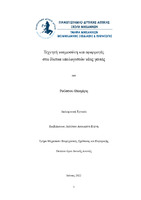| dc.contributor.advisor | Leligou, Helen C. (Nelly) | |
| dc.contributor.author | Ρούσσου, Θεοχάρη | |
| dc.date.accessioned | 2022-08-03T08:09:49Z | |
| dc.date.available | 2022-08-03T08:09:49Z | |
| dc.date.issued | 2022-07-14 | |
| dc.identifier.uri | https://polynoe.lib.uniwa.gr/xmlui/handle/11400/2740 | |
| dc.identifier.uri | http://dx.doi.org/10.26265/polynoe-2580 | |
| dc.description.abstract | Η βέλτιστη χρήση των πόρων υποδομής είναι ένα ιδιαίτερα επιθυμητό , αλλά παράλληλα πολύπλοκο έργο για τους παρόχους δικτυακού service. Αυτό συμβαίνει διότι η βέλτιστη ποσότητα τέτοιων πόρων είναι μία συνάρτηση από διάφορες παραμέτρους, όπως είναι η επιθυμητή / συμφωνημένη ποιότητα υπηρεσιών (QoS) , τα χαρακτηριστικά / προφίλ του service, ο όγκος εργασίας και ο κύκλος ζωής της. Η θεμελίωση πλαισίων (frameworks) που προβλέπουν τη δυναμική εγκατάσταση και την τοποθέτηση υπηρεσιών και δικτυακών λειτουργιών συμβάλλει περαιτέρω στη μείωση της αποτελεσματικότητας των παραδοσιακών μεθόδων κατανομής πόρων. Στην έρευνα αυτή, αντιμετωπίζεται αυτό το πρόβλημα με την ανάπτυξη ενός μηχανισμού, ο οποίος αρχικά πραγματοποιεί σκιαγράφηση της υπηρεσίας, και έπειτα εκτελεί μία πρόβλεψη των πόρων που θα χρειαστούν ώστε να οδηγηθεί στο επιθυμητό QoS για κάθε νέα υπηρεσία που αναπτύσσεται. Τα κύρια στοιχεία της προσέγγισης είναι τα παρακάτω: α) τη συλλογή δεδομένων και από τα τρία επίπεδα των εγκατεστημένων υποδομών (hardware/ υλισμική , virtual/ εικονική, service) αντί για ένα μόνο επίπεδο, για να παρέχεται μία καθαρότερη εικόνα σε πιθανές διακοπές του συστήματος, β) η μελέτη γνωστών εφαρμογών που βασίζονται στην υποδομή των containers ακολουθώντας την αρχιτεκτονική των microservices και γ) τη χρήση μίας διαδικασίας ανάλυσης δεδομένων που χρησιμοποιεί ένα σύνολο αλγορίθμων μηχανικής μάθησης και εκτελεί ακριβείς προβλέψεις για τους πόρους που απαιτούνται για μελλοντικά αιτήματα υπηρεσιών. Διερευνάται η απόδοση του προτεινόμενου framework χρησιμοποιώντας την εφαρμογή ανοικτού κώδικα ώστε να εξεταστεί η περίπτωση ενός συμπλέγματος Hadoop. Τα αποτελέσματα δείχνουν ότι εκτελώντας έναν μικρό αριθμό δοκιμών είναι εφικτό να αξιολογηθούν τα κύρια σημεία διακοπής του συστήματος και ταυτόχρονα να επιτευχθούν ακριβείς προβλέψεις των πόρων που θα χρειαστούν για μελλοντικά αιτήματα. | el |
| dc.format.extent | 38 | el |
| dc.language.iso | el | el |
| dc.publisher | Πανεπιστήμιο Δυτικής Αττικής | el |
| dc.rights | Αναφορά Δημιουργού - Μη Εμπορική Χρήση - Παρόμοια Διανομή 4.0 Διεθνές | * |
| dc.rights | Attribution-NonCommercial-NoDerivatives 4.0 Διεθνές | * |
| dc.rights.uri | http://creativecommons.org/licenses/by-nc-nd/4.0/ | * |
| dc.subject | Τεχνητή νοημοσύνη | el |
| dc.subject | Μηχανική μάθηση | el |
| dc.subject | QoS | el |
| dc.subject | Containers | el |
| dc.subject | Μικροϋπηρεσίες | el |
| dc.subject | Hadoop cluster | el |
| dc.subject | Artificial intelligence | el |
| dc.subject | Machine learning | el |
| dc.subject | Microservices | el |
| dc.subject | Δίκτυα | el |
| dc.subject | Software-defined networking | el |
| dc.subject | Δικτύωση καθορισμένη από λογισμικό | el |
| dc.title | Τεχνητή νοημοσύνη και εφαρμογές στα δίκτυα υπολογιστών νέας γενιάς | el |
| dc.title.alternative | Artificial Intelligence and applications in next generation computer networks | el |
| dc.type | Διπλωματική εργασία | el |
| dc.contributor.committee | Παπουτσιδάκης, Μιχαήλ | |
| dc.contributor.committee | Pallis, Evangelos | |
| dc.contributor.faculty | Σχολή Μηχανικών | el |
| dc.contributor.department | Τμήμα Μηχανικών Βιομηχανικής Σχεδίασης και Παραγωγής | el |
| dc.description.abstracttranslated | The optimal use of infrastructure resources is a highly desirable, but at the same time complex task for network service providers. This is because the optimal amount of such resources is a function of several parameters, such as the desired / agreed quality of service (QoS), the characteristics / profile of the service, the workload and its life-cycle. The establishment of frameworks that predicts the dynamic establishment and placement of service and network functions further contributes to reducing the effectiveness of traditional resource allocation methods. In this research, this problem is addressed by developing a mechanism, which first performs service profiling, and then a prediction of the resources that will be needed to achieve the desired Qos for each new deployed service. The main elements of this approach are the following: a) the collection of data of all three layers of the deployed infrastructure (hardware, virtual, service), instead of a single layer, to provide a clearer picture of the possible system break points, b) a study of well-known container based applications following the microservice architecture, and c) the use of a data analysis process that uses a set of machine learning algorithms and performs accurate predictions of the required resources for future service requests. The performance of the proposed framework is investigated using the open-source implementation to consider the case of a Hadoop cluster. The results show that by running a small number of tests it is possible to assess the main system break points and at the same time achieve accurate predictions of the resources that will be needed for future requests. | el |


